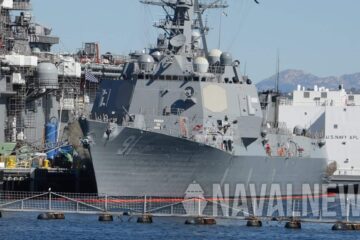The U.S. Navy’s future approach to capitalizing on the advancing technological progress of robotics, computers, software and hardware is building and fielding small and large unmanned systems. These unmanned systems will go into harm’s away, perform laborious dangerous mundane tasks, execute high-risk missions, and will have high endurance and loitering times. The U.S. Navy hopes that unmanned ships will bolster the “U.S Navy Ship Count” to complement and provide benefits to its manned surface vessels for Distributed Maritime Operations and Distributed Lethality.
Naval News has published several articles on the Medium Unmanned Surface Vessel (MUSV)
here and here and for the Large Unmanned Surface Vessel (LUSV) here, and here.
At the virtual Surface Navy Association’s 2021 Waterfront Symposium held on 26 August, 2021, the “U.S. Navy Operators Panel,” consisting of Captains and Lieutenant Commanders sitting on an open stage under a tent, offered insight as to the Navy’s vision for the MUSV and the LUSV.

Captain Andy Liggett, USN, Commanding Officer, USS Michael Monsoor, remarked, “This is happening fast,” citing the U.S. Navy’s operational experience and learning of unmanned systems with advancement progress occurring in months instead of much longer than initially thought. LCDR Ryan Doyle, USN, Combat Systems Officer, Destroyer Squadron Twenty-One said a good example of using unmanned systems is for risky battle damage assessment and to close the “Kill Chain” [the process of networking sensor to shooter] instead of using a manned helicopter or a destroyer to accomplish the same mission. However, Captain Sean Rocheleau, USN, Commanding Officer, HSMWP, who commands MQ-8 Fire Scout UASs, admitted that unmanned systems do have limitations when employed. For example, Captain Rocheleau said that the MQ-8 has “Great ISR [Intelligence, Surveillance, Reconnaissance sensors] but it won’t go into the `blunt edge.’ There are certain environments where you don’t want to throw a helicopter in no matter what [such as against an enemy destroyer since the MQ-8 is mainly used as a sensing platform].”
LCDR Jon Noda, USN, SURFDEVRON, N5 provided the most information on the U.S. Navy’s unmanned systems. Noda mentioned that the U.S. Navy’s USV Program is still pretty new, observing, “We’re in this game pretty early.” Noda stated that the U.S. Navy wants to close the “Acquisition Gap” in order to get the Unmanned Surface Vessels (USVs) into the Fleet sooner to maximize their value and benefits, and as an example, Noda mentioned that the U.S. Navy drone ship, Sea Hunter, is operating with USS Anchorage right now.
The audience asked a question on how the U.S. Navy intends to maintain the physical security for USVs when deployed. LCDR Noda didn’t elaborate on the hardware side, but did mention that securing the software is important.

Another audience question asked about the intended functions for the MUSV and the LUSV. LCDR Noda replied that for the FY2022 plan, the MUSV will have the sensors and electronics payloads, and that the MUSV will be delivered first. The LUSV is meant to act as the adjunct magazine [think multiple VLS cells] with the LUSV being further out in the scheduled delivery.
LCDR Noda also elaborated that a big project within the USV Program is understanding the USV data and how to use that data, or akin to “Information overload” where so much USV data is generated that the USV Operators have to analyze all the information in a given amount of time to make operational decisions. Noda stressed that USV data needs a fast turnaround—how did the USV perform tactically according to the USV’s data? A second aspect, according to Noda, is that the U.S. Navy has to establish trust in the autonomous systems—how much can the U.S. Navy trust the USVs to go out there into the open ocean on their own, unmanned and unescorted, and are the USVs actually ready to do this? Does the USV Operator trust the USV enough to perform the mission autonomously? “Is it [the USV] doing what I want it to do the way I would do it?” asked Noda to the audience. Thus, the issue is processing the USV’s data fast and timely enough, and needing that data today (for instance), to make the USV Operator decide on the USV’s future usage and operations (USV turnaround time). Without that USV- gathered data processed and analyzed in a fast and timely manner by Human USV Operators, Noda admitted that it will be hard to trust the USVs to go out there autonomously.
LCDR Noda also referred to an Internet joke about how common End Users often don’t believe in the drones’ and software’s quality and performance and thus are initially skeptical with the drone industries Developers’ and the Programmers’ robots and AI prototypes. However, that time is gone, confessed Noda, because the End Users do have the AI robotic systems now, and can provide the feedback on unmanned systems to state what is wrong based on USV Operator experience and gathered USV data. LCDR Noda closed by asserting that the End Users need to engage early with the drone industry programmers and developers and provide feedback about using these prototype unmanned systems.






